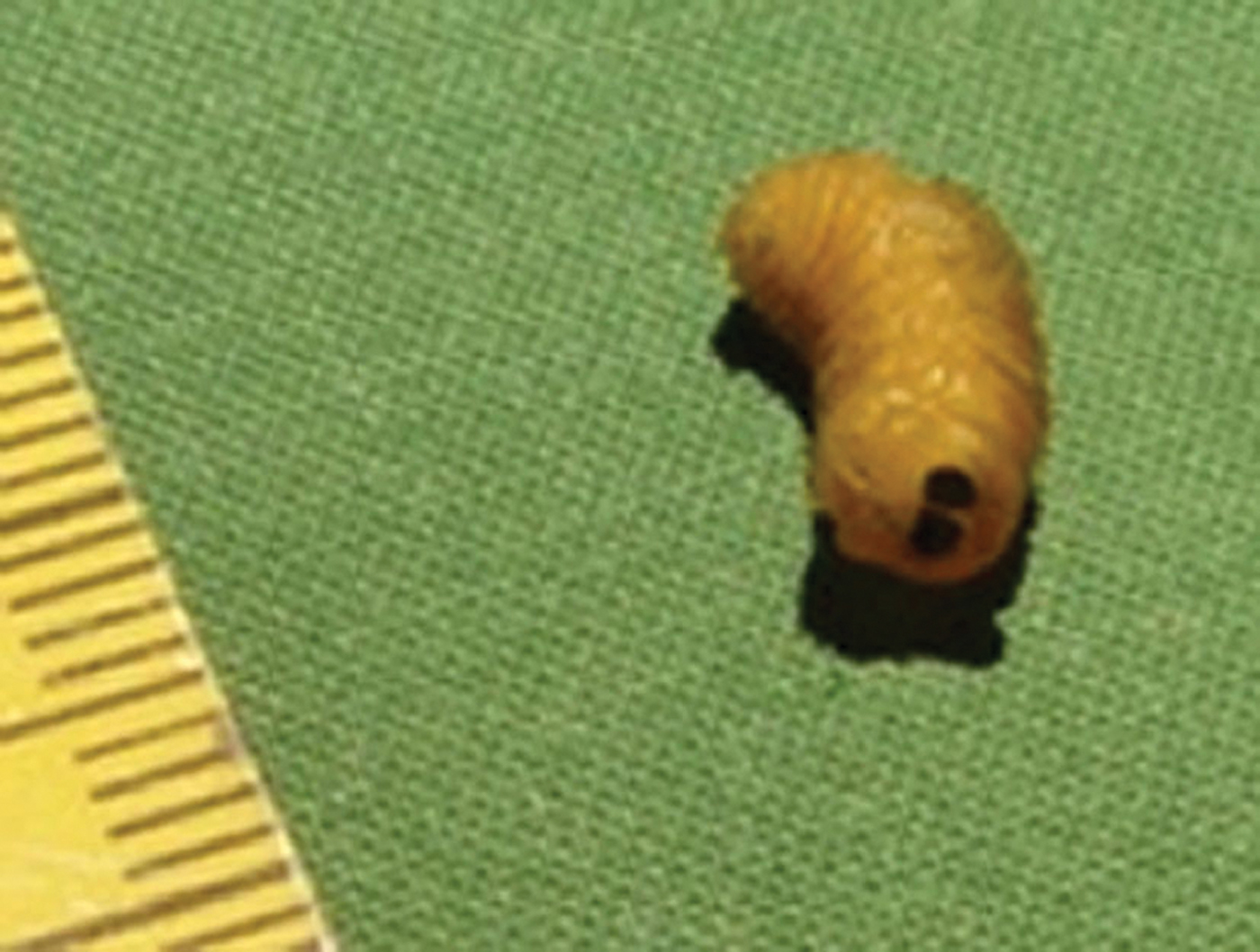Introduction
Infestation of tissue by fly larvae is termed myiasis, and it is unusual in humans. Several different types of flies can produce myiasis in the head and neck region, with more or less aggressive modes of action.Reference Duque, Marrugo and Valderrama1 Endoscopes are valuable for the removal of larvae.Reference Soni2
The sheep nasal bot fly Oestrus ovis (named by Linnaeus in 1758) is a diptera fly which normally develops through three larval stages as a parasite within the sinonasal units of sheep or goats during winter. The bee-like adult fly is 10–12 mm long. As the female insect flies by, it squeezes a droplet full of larvae (at this stage 1 mm in length) into the sheep's nostrils. The larvae adhere to the nasal mucosa with strong hooks, which enable them to resist being expelled by sneezing.Reference Macdonald, Chan, Dickson, Jean-Louis and Heath3
Oestrus ovis has been extinct in Sweden since the late nineteenth century, but is still common in many parts of the world. The most common site of human infestation is the conjunctival sac, resulting in ophthalmomyiasis.Reference Kuk, Yildirim, Ozden, Erensoy and Saki4 Other ports of entry include the ears, mouth and nose.Reference Macdonald, Chan, Dickson, Jean-Louis and Heath3 Most reported patients with nasal myiasis have not been in contact with sheep, but some have been aware of a fly.
Case report
A healthy, 65-year-old Swedish man spent a week at a modern holiday resort on the Greek island of Samos, in June 2008. During his stay abroad, he ‘caught a cold’. Secretions from his left nostril persisted for a month, until he sneezed out a live white larva, which measured 12 × 5 mm. He froze the larva and brought it to our clinic, where it was placed in formalin. The Swedish National Veterinary Institute identified as a second stage O ovis larva (Figure 1).

Fig. 1 Second stage Oestrus ovis larva, which had infested the nose of a healthy Swedish man.
Flexible endoscopy of the patient's nose, and the left maxillary sinus (via a wide ostium), revealed no further larvae.
Subsequently, the patient's nasal problems resolved completely.
He could not recall any attack by a fly, or contact with sheep or goats, either in Greece or at home.
Discussion
Earlier reports of human nasal myiasis due to O ovis described first stage larvae, and concluded that development into the second stage was not possible outside the normal host.Reference Macdonald, Chan, Dickson, Jean-Louis and Heath3, Reference Quesada, Navarrete and Maeso5 Some authors still believe this.Reference Kuk, Yildirim, Ozden, Erensoy and Saki4 However, the cases mentioned below, as well as our own, would seem to indicate that it is possible for larvae to develop into the second and even third stage, within humans.
Uriarte and Ell reported the case of a British male who was infested while on holiday in Spain. Two weeks later, he sneezed out two second stage larvae.Reference Uriarte and Ell6 Another two were removed from his nose by endoscopy under general anaesthesia. Due to asthma, he had been taking prednisolone 10 mg daily, and the resultant immunosuppression may have facilitated transformation of the larvae within the foreign host.
The first reported case of human nasal myiasis with third stage O ovis larvae occurred in a human immunodeficiency virus positive, urban, English man, who had not travelled abroad or to the countryside.Reference Badia and Lund7 He had been sneezing out larvae for six weeks and had a frontal headache and a feeling of crawling in his nose. The larvae had invaded a concha bullosa and the ethmoidal and sphenoid sinuses, and were removed by endoscopic sinus surgery.
• A patient who feels that something is crawling inside their nose or sinuses may be correct
• Sinonasal infestation by the sheep nasal bot fly has been described in several humans
• The reported case is the third to demonstrate development beyond the first larva stage, within the nose of an immunocompetent human
In Spain, third stage infestation was described in a healthy, non-immunocompromised man.Reference Lucientes, Clavel, Ferrer-Dufol, Valles, Peribanez and Gracia-Salinas8 This patient had also suffered symptoms for several weeks; however, as there were no signs of illness, his suffering was mistaken for a psychiatric disorder. However, symptoms disappeared after the larvae spontaneously left his nose.
A French woman reported rhinitis symptoms three weeks after having spent a fortnight on the Mediterranean coast, without any animal contact. Her symptoms disappeared after she sneezed out two second stage and one third stage larvae.Reference Delhaes, Bourel, Pinatel, Cailliez, Gosset and Camus9
Our patient's infestation was probably imported from Greece. This patient represents the third reported case showing sinonasal development of O ovis beyond the first larval stage in an immunocompetent human.
Acknowledgement
Larval identification was performed by Jan Chirico at the Department of Parasitology, National Veterinary Institute, Uppsala, Sweden.



